In Photos: Strange Purple Orb Found in Pacific Ocean
A marine mystery
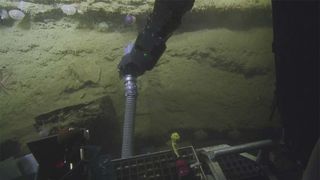
Researchers aboard the E/V Nautilus were surprised to stumble across a mysterious purple blob during an exploration of Arguello Canyon near the Channel Island National Marine Sanctuary on July 18. Stumped as to the orb's identity, they collected it with the suction tool on the ROV Hercules. [Read the full story on the purple orb]
Tiny disco ball?
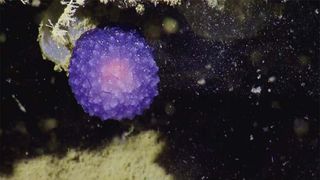
This mysterious orb was found tucked under a rocky shelf 5,301 feet (1,616 meters) below the ocean surface. It's about two inches (5 centimeters) wide. Once taken aboard the E/V Nautilus, it unfurled into two lobes. Researchers currently think it might be an unknown species of gastropod called a pleurobranch. [Read the full story on the purple orb]
Crab scuttle
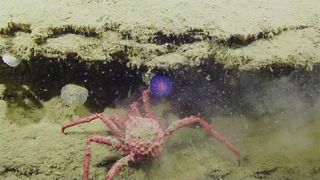
A crab scuttles out of the way in Arguello Canyon in the eastern Pacific, as researchers use the cameras on the ROV Hercules to get a closer look at a mysterious purple orb. The research team on the E/V Nautilus has spent the summer field season traveling southward down the west coast of Canada and the United States, exploring unknown marine ecosystems.
Light it up
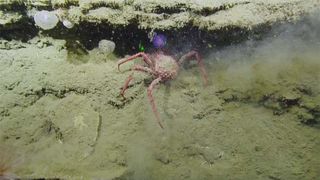
Green lasers pinpoint the purple blob for collection by the ROV Hercules suction tool. The tool sucks samples into a storage area on the ROV. They're then brought to the surface for analysis. Researchers onboard the Nautilus conducted an initial study of the purple blob and then sent it to the Harvard Museum of Comparative Zoology. If it is a new species, that fact will take months to confirm.
Strange Orb
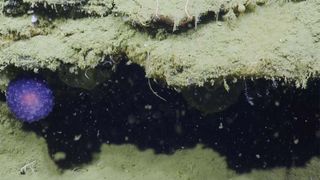
Researchers aboard the Nautilus first speculated that the blob might be a salp, a type of marine invertebrate, or perhaps an egg sack. The discovery was broadcast at www.nautiluslive.org, which streams video and audio from the ship's expeditions. [Read the full story on the purple orb]
Channel Island Creatures
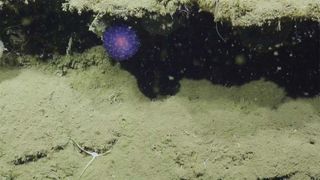
The purple orb was found during a nearly three-week exploration of the Channel Islands National Marine Sanctuary and its surroundings. Less than half of the sanctuary's seafloor has been mapped, according to the Ocean Exploration Trust, the non-profit that manages the Nautilus. The ship's crew conducted mapping as well as searches for geological and biological samples.
Unfolding Mystery
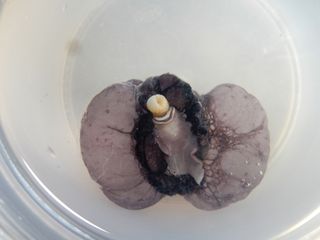
Once aboard the E/V Nautilus, the purple orb unfolded into something with two separate lobes. So far, scientists suspect it may be a pleurobranch, which is a type of mollusk related to the more famous nudibranchs. Both lack shells, but pleurobranches are distinguished by two specifically placed ear-like structures called rhinophores and a gill on the right side, according to Nautilus researchers.
Sign up for the Live Science daily newsletter now
Get the world’s most fascinating discoveries delivered straight to your inbox.
Unknown species
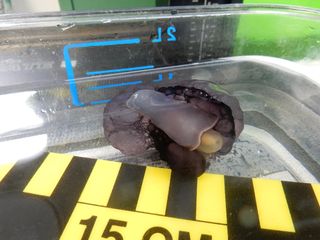
No known pleurobranch in California waters is purple, said Nautilus spokeswoman Susan Poulton. That means this organism may be a new species. It's also possible that the species is known from other regions, but that this discovery expands its range.
Purple Blob
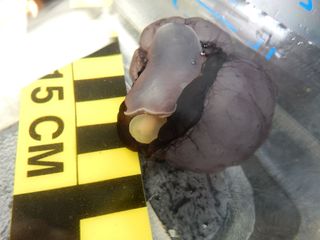
A measuring stick next to the mystery mollusk found in Arguello Canyon. The E/V Nautilus began the summer 2016 field season in May exploring off the coast of Canada's Vancouver Island, and has been working its way down through Cascadia and along the California coast since. As of July 24, the ship is exploring the Southern California Margin off the coast of Los Angeles.
Stumping scientists
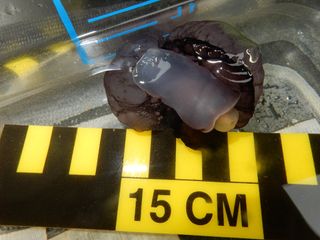
Starting in August, the Nautilus will travel north to the Greater Farallones National Marine Sanctuary, where researchers will send an ROV to explore the USS Independence, a naval ship scuttled in 1951. They will also explore the 1800s shipwreck of the Ituna and the wreck of the Dorothy Windermote.
Strange Species
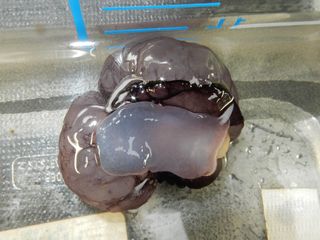
Nautilus researchers sometimes find new species when exploring untraveled areas, spokeswoman Susan Poulton said, but it can take a long time to confirm that a species is new. The final leg of the 2016 field season will send the ship to the California Borderland region, a largely unmapped area of the ocean spanning between San Diego and San Francisco. The team will use altimeters to detect gravity anomalies that indicate dips and rises in the ocean floor, allowing them to create high-resolution maps of the seafloor.

Stephanie Pappas is a contributing writer for Live Science, covering topics ranging from geoscience to archaeology to the human brain and behavior. She was previously a senior writer for Live Science but is now a freelancer based in Denver, Colorado, and regularly contributes to Scientific American and The Monitor, the monthly magazine of the American Psychological Association. Stephanie received a bachelor's degree in psychology from the University of South Carolina and a graduate certificate in science communication from the University of California, Santa Cruz.










